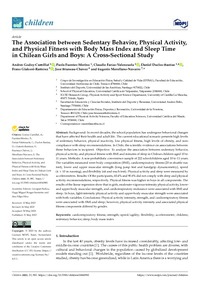Mostrar el registro sencillo de la publicación
The association between sedentary behavior, physical activity, and physical fitness with body mass index and sleep time in chilean girls and boys: a cross-sectional study
| dc.contributor.author | Godoy Cumillaf, Andrés | |
| dc.contributor.author | Fuentes-Merino, Paola | |
| dc.contributor.author | Farías-Valenzuela, Claudio | |
| dc.contributor.author | Duclos-Bastías, Daniel | |
| dc.contributor.author | Giakoni-Ramírez, Frano | |
| dc.contributor.author | Bruneau-Chávez, José | |
| dc.contributor.author | Merellano-Navarro, Eugenio | |
| dc.date.accessioned | 2023-08-17T18:02:11Z | |
| dc.date.available | 2023-08-17T18:02:11Z | |
| dc.date.issued | 2023 | |
| dc.identifier.uri | http://repositorio.ucm.cl/handle/ucm/4907 | |
| dc.description.abstract | Background: In recent decades, the school population has undergone behavioral changes that have affected their health and adult life. The current educational scenario presents high levels of sedentary behavior, physical inactivity, low physical fitness, high levels of obesity, and non compliance with sleep recommendations. In Chile, the scientific evidence on associations between these behaviors is incipient. Objective: To analyze the association between sedentary behavior, physical activity, and physical fitness with BMI and minutes of sleep in Chilean children aged 10 to 11 years. Methods: A non-probabilistic convenience sample of 222 schoolchildren aged 10 to 11 years. The variables measured were body composition (BMI), cardiorespiratory fitness (20 m shuttle run test), lower and upper muscular strength (long jump test and handgrip dynamometry), speed (4 × 10 m running), and flexibility (sit and reach test). Physical activity and sleep were measured by accelerometers. Results: Of the participants, 60.4% and 90.6% did not comply with sleep and physical activity recommendations, respectively. Physical fitness was higher in boys in all components. The results of the linear regression show that in girls, moderate–vigorous-intensity physical activity, lower and upper-body muscular strength, and cardiorespiratory endurance were associated with BMI and sleep. In boys, light-intensity physical activity and upper-body muscular strength were associated with both variables. Conclusions: Physical activity intensity, strength, and cardiorespiratory fitness were associated with BMI and sleep; however, physical activity intensity and associated physical fitness components differed by gender. | es_CL |
| dc.language.iso | en | es_CL |
| dc.rights | Atribución-NoComercial-SinDerivadas 3.0 Chile | * |
| dc.rights.uri | http://creativecommons.org/licenses/by-nc-nd/3.0/cl/ | * |
| dc.source | Children, 10(6), 981 | es_CL |
| dc.subject | Cardiorespiratory fitness | es_CL |
| dc.subject | Strength | es_CL |
| dc.subject | Speed/agility | es_CL |
| dc.subject | Flexibility | es_CL |
| dc.subject | Accelerometer | es_CL |
| dc.subject | Children | es_CL |
| dc.subject | Sedentary behavior | es_CL |
| dc.subject | Sleep | es_CL |
| dc.subject | Body mass index | es_CL |
| dc.title | The association between sedentary behavior, physical activity, and physical fitness with body mass index and sleep time in chilean girls and boys: a cross-sectional study | es_CL |
| dc.type | Article | es_CL |
| dc.ucm.facultad | Facultad de Ciencias de la Educación | es_CL |
| dc.ucm.indexacion | Scopus | es_CL |
| dc.ucm.indexacion | Isi | es_CL |
| dc.ucm.uri | mdpi.com/2227-9067/10/6/981 | es_CL |
| dc.ucm.doi | doi.org/10.3390/children10060981 | es_CL |



